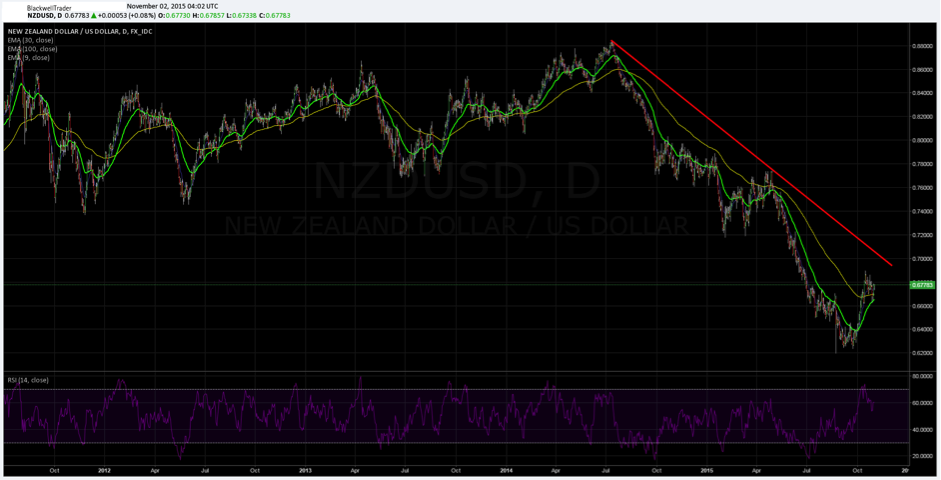However, given the RBNZ’s recent comments regarding a rate hike, it seems unlikely December will see a cut from the central bank. In fact, the RBNZ’s Governor Wheeler made a statement in the middle of October outlining the case for leaving the Official Cash Rate (OCR) unchanged. Although the venerable central banker did concede that the OCR may need to decrease in the short term if conditions worsen.
In addition, a bevy of economists are urging the central bank to take a conservative approach to any further cuts given the need to retain sufficient capacity to cut if global conditions decline. There appears to be a view that there is a diminishing return in attempting to stoke inflation solely through the manipulation of rates. This is particularly salient given the effect of rolling rounds of currency depreciations that are currently occurring throughout Asia. Subsequently, the higher Kiwi dollar complicates both the trade balance and export competitiveness.
It is highly likely that the RBNZ will seek to delay any rate cut in December despite the dovish rhetoric from the NZ Finance Minister. Thankfully, economic policy drives rate setting, not political ambitions.
NZD: Subsequent Outlook - Bearish
The NZD had a largely volatile week as New Zealand’s trade balance deteriorated to -1.22B along with exports dipping significantly. The pair subsequently experienced a sharp decline of around 80 pips before the RBNZ helped to fuel a rally when they elected to hold interest rates steady at 2.75%. The NZD subsequently managed to close the week only fractionally lower, around the 0.6773 mark.
The week ahead will largely be focused upon the NZ Global Dairy Trade (GDT) and Unemployment figures. The dairy trade result will be closely monitored by the market given the recent deterioration in New Zealand exports. Also, recent comments from the NZ Finance Minister indicate a definite dovish bias and are likely to impact the pair in the short term. On the news front, keep a close watch upon the US NFP’s as they are likely to cause some sharp volatility within the markets.
From a technical perspective, the NZD is being squeezed between the long run bearish trend line and the 100-Day moving average. That consolidating wedge is likely breakout in the coming week with a bias to the downside. Subsequently, monitor the pair closely for a break below the 100-Day MA. Support is found at 0.6631, 0.6497, and 0.6408. Resistance is found at 0.6895, 0.7013, and 0.7229.

Risk Warning: Any form of trading or investment carries a high level of risk to your capital and you should only trade with money you can afford to lose. The information and strategies contained herein may not be suitable for all investors, so please ensure that you fully understand the risks involved and you are advised to seek independent advice from a registered financial advisor. The advice on this website is general in nature and does not take into account your objectives, financial situation or needs. You should consider whether the advice is suitable for you and your personal circumstances. The information in this article is not intended for residents of New Zealand and use by any person in any country or jurisdiction where such distribution or use would be contrary to local law or regulation. Knight Review is not a registered financial advisor and in no way intends to provide specific advice to you in any form whatsoever and provide no financial products or services for sale. As always, please take the time to consult with a registered financial advisor in your jurisdiction for a consideration of your specific circumstances.
Recommended Content
Editors’ Picks
EUR/USD holds above 1.0700 ahead of key US data

EUR/USD trades in a tight range above 1.0700 in the early European session on Friday. The US Dollar struggles to gather strength ahead of key PCE Price Index data, the Fed's preferred gauge of inflation, and helps the pair hold its ground.
USD/JPY stays above 156.00 after BoJ Governor Ueda's comments

USD/JPY holds above 156.00 after surging above this level with the initial reaction to the Bank of Japan's decision to leave the policy settings unchanged. BoJ Governor said weak Yen was not impacting prices but added that they will watch FX developments closely.
Gold price oscillates in a range as the focus remains glued to the US PCE Price Index

Gold price struggles to attract any meaningful buyers amid the emergence of fresh USD buying. Bets that the Fed will keep rates higher for longer amid sticky inflation help revive the USD demand.
Sei Price Prediction: SEI is in the zone of interest after a 10% leap

Sei price has been in recovery mode for almost ten days now, following a fall of almost 65% beginning in mid-March. While the SEI bulls continue to show strength, the uptrend could prove premature as massive bearish sentiment hovers above the altcoin’s price.
US core PCE inflation set to signal firm price pressures as markets delay Federal Reserve rate cut bets

The core PCE Price Index, which excludes volatile food and energy prices, is seen as the more influential measure of inflation in terms of Fed positioning. The index is forecast to rise 0.3% on a monthly basis in March, matching February’s increase.